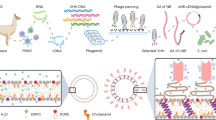Abstract
Purpose: Simple methods for the large-scale manufacture of ligand-targeted liposomes will be needed if clinical trials are to proceed. We tested a recently developed technology for inserting peptide ligands into preformed Stealth liposomes. Antagonist G-targeted liposomes (PLG) were prepared and loaded with doxorubicin and their cellular association and cytotoxicity were evaluated using the human small cell lung cancer H69 cell line.
Methods: The hexapeptide antagonist G was covalently coupled via a thioether bond to the terminus of polyethylene glycol (PEG) in micelles formed from maleimide-derivatized poly(ethylene glycol) (Mr 2000) distearoylphosphatidylethanolamine followed by transfer into preformed liposomes during a one-step incubation. For cellular association, we used radiolabeled liposomes. Cytotoxicity was evaluated using the MTT in vitro proliferation assay.
Results: The postinsertion approach to the formation of peptide-targeted liposomes led to the production of PLG bearing a maximum of approximately 0.3 μg antagonist G/μmol phospholipid. These liposomes had increased cellular association to H69 cells relative to nontargeted liposomes and, when loaded with doxorubicin, they resulted in similar levels of cytotoxicity to those obtained by conventional coupling techniques.
Conclusions: The postinsertion technique is a simple, effective means for the production of biologically active peptide-targeted liposomes.
Similar content being viewed by others
REFERENCES
D. Papahadjopoulos, T. M. Allen, A. Gabizon, E. Mayhew, K. Matthay, S. K. Huang, K. D. Lee, M. C. Woodle, D. D. Lasic, C. Redemann, and F. J. Martin. Sterically stabilized liposomes: improvements in pharmacokinetics and antitumor therapeutic efficacy. Proc. Natl. Acad. Sci. USA 88:11460–11464 (1991).
D. W. Northfelt, F. J. Martin, P. Working, P. A. Volberding, J. Russell, M. Newman, M. A. Amantea, and L. D. Kaplan. Doxorubicin encapsulated in liposomes containing surface-bound polyethylene glycol: pharmacokinetics, tumor localization, and safety in patients with AIDS-related Kaposi's sarcoma. J. Clin. Pharmacol. 36:55–63 (1996).
D. E. Lopes de Menezes, L. M. Pilarski, and T. M. Allen. In vitro and in vivo targeting of immunoliposomal doxorubicin to human B-cell lymphoma. Cancer Res. 58:3320–3330 (1998).
P. J. Woll and E. Rozengurt. A neuropeptide antagonist that inhibits the growth of small cell lung cancer in vitro. Cancer Res. 50:3968–3973 (1990).
J. N. Moreira, C. B. Hansen, R. Gaspar, and T. M. Allen (eds.). Controlled Release Society, Inc. In vitro targeting of poly(ethylene glycol)-grafted liposomes by hexapeptide to a classical small cell lung cancer cell line. In Proceedings of the 26th International Symposium on Controlled Release of Bioactive Materials, June 20-25, Boston, Massachusetts, 1999, p. 6215.
J. N. Moreira, C. B. Hansen, R. Gaspar, and T. M. Allen (eds.). Organizing Committee of the IV Spanish-Portuguese Conference on Controlled Drug Delivery. Pharmacokinetic properties and biodistribution of hexapeptide-targeted Stealth® liposomes. In Proc. IV Spanish-Portuguese Conference on Controlled Drug Delivery, September 17-20, Vitoria, Spain, 2000, pp. 169–170.
S. Zalipsky, N. Mullah, J. A. Harding, J. Gittelman, L. Guo, and S. A. DeFrees. Poly(ethylene glycol)-grafted liposomes with oligopeptide or oligosaccharide ligands appended to the termini of the polymer chains. Bioconjug. Chem. 8:111–118 (1997).
P. S. Uster, T. M. Allen, B. E. Daniel, C. J. Mendez, M. S. Newman, and G. Z. Zhu. Insertion of poly(ethylene glycol) derivatized phospholipid into pre-formed liposomes results in prolonged in vivo circulation time. FEBS Lett. 386:243–246 (1996).
T. Ishida, D. L. Iden, and T. M. Allen. A combinatorial approach to producing sterically stabilized (Stealth) immunoliposomal drugs. FEBS Lett. 460:129–133 (1999).
F. Olson, C. A. Hunt, F. C. Szoka, W. J. Vail, and D. Papahadjopoulos. Preparation of liposomes of defined size distribution by extrusion through polycarbonate membranes. Biochim. Biophys. Acta 557:9–23 (1979).
E. M. Bolotin, R. Cohen, L. K. Bar, N. Emanuel, S. Ninio, D. D. Lasic, and Y. Barenholz. Ammonium sulphate gradients for efficient and stable remote loading of amphipatic weak bases into liposomes and ligandoliposomes. J. Liposome Res. 4:455–479 (1994).
G. R. Bartlett. Phosphorus assay in column chromatography. J. Biol. Chem. 234:466–468 (1959).
G. T. Hermanson. Introduction of sulfhydryl residues (thiolation): modification of amines with 2-iminothiolane (Traut's reagent). In G. T. Hermanson, (ed.), Bioconjugate Techniques, Academic Press, San Diego, California, 1996, pp. 56–60.
R. Jue, J. M. Lambert, L. R. Pierce, and R. R. Traut. Addition of sulfhydryl groups to Escherichia coli ribosomes by protein modification with 2-iminothiolane (methyl 4-mercaptobutyrimidate). Biochemistry 17:5399–5406 (1978).
G. E. Means and R. E. Feeney. Chemical modifications of proteins: history and applications. Bioconjug. Chem. 1:2–12 (1990).
F. J. Martin and D. Papahadjopoulos. Irreversible coupling of immunoglobulin fragments to preformed vesicles. An improved method for liposome targeting. J. Biol. Chem. 257:286–288 (1982).
D. E. Lopes de Menezes, M. J. Kirchmeier, J. F. Gagne, L. M. Pilarski, and T. M. Allen. Cellular trafficking and cytotoxicity of anti-CD19-targeted liposomal doxorubicin in B lymphoma cells. J. Liposome Res. 9:199–228 (1999).
D. Kirpotin, J. W. Park, K. Hong, S. Zalipsky, W. L. Li, P. Carter, C. C. Benz, and D. Papahadjopoulos. Sterically stabilized anti-HER2 immunoliposomes: design and targeting to human breast cancer cells in vitro. Biochemistry 36:66–75 (1997).
D. L. Iden and T. M. Allen. In vitro and in vivo comparison of immunoliposomes made by conventional coupling techniques with those made by a new post-insertion approach. Biochim. Biophys. Acta 1513:207–216 (2001).
D. C. Litzinger, A. M. Buiting, N. van Rooijen, and L. Huang. Effect of liposome size on the circulation time and intraorgan distribution of amphipathic poly(ethylene glycol)-containing liposomes. Biochim. Biophys. Acta 1190:99–107 (1994).
O. Ishida, K. Maruyama, K. Sasaki, and M. Iwatsuru. Sizedependent extravasation and interstitial localization of polyethyleneglycol liposomes in solid tumor-bearing mice. Int. J. Pharm. 190:49–56 (1999). Insertion of Peptide Ligands into Stealth Liposomes 269
Author information
Authors and Affiliations
Rights and permissions
About this article
Cite this article
Moreira, J.N., Ishida, T., Gaspar, R. et al. Use of the Post-Insertion Technique to Insert Peptide Ligands into Pre-Formed Stealth Liposomes with Retention of Binding Activity and Cytotoxicity. Pharm Res 19, 265–269 (2002). https://doi.org/10.1023/A:1014434732752
Issue Date:
DOI: https://doi.org/10.1023/A:1014434732752




